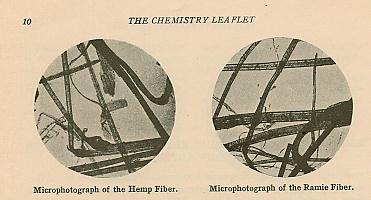
Microphotographs of Hemp and Ramie fiber
| HEMPOLOGY.ORG: THE STUDY OF HEMP
|
|||
|
|
||
Pubdate: December 11, 1930
Source: The Chemistry Leaflet; Volume IV, Number 14 - The World's
Clothing Supply
Student Supplement, Journal of Chemical Education
"A Weekly Publication Designed to Interest the Student Taking
Chemistry for the First Time"
Pages: 9-10

Hemp is met with commonly nowadays, inasmuch as it is used as a linen substitute in articles varying all the way from face towels to men's sport knickers.
Although hemp is much too coarse to lend itself to the making of fine fabrics, it is used to a considerable extent in the manufacture of heavier types of cloth which resemble coarse linen in appearance. So close is this resemblance in many cases that many people confuse it with linen continually. As a matter of fact, only an expert can tell hempen articles from coarse linen ones by superficial examination. Even he sometimes needs a microscope in order to be absolutely sure in his judgment.
Chemical tests for the differentiation of hemp and linen are of no value since both consist almost entirely of cellulose. The microscopic structure of the fibers differ considerably, and this makes it possible to distinguish them from each other in the textile laboratory.
WHERE HEMP COMES FROM
The hemp is an annual plant of the nettle tribe, and is called "cannabis sativa" by the botanists. Our word canvas comes from this botanical name. The term "canvas" was originally coined to refer to any cloth made from hemp. It later came to be applied only to extremely coarse hempen fabrics, and finally to coarse fabrics made from any suitable fiber.
The hemp plant is native of China, India, and Persia, but its cultivation has spread to many parts of the world. Germany and Scandanavia have produced hemp for centuries. It is grown also in France, Italy, Russia, Great Britain, and the United States.
Kentucky is the center of the hemp growing industry of this country. Nebraska, California, Texas and Illinois also produce it in small amounts.
PRODUCTION OF HEMP
The hemp seed is sown in the spring after a fall and a spring plowing. The aim of the hemp grower is to raise stalks of somewhat the same size, since this assures a more nearly uniform diameter in the fibers. The harvesting requires extreme care. The removal of the fibers from the rest of the stalk is done in the same general way as in linen, dew-retting being the method most generally used. Under average conditions an acre of hemp yields about 1000 pounds of rough fiber.